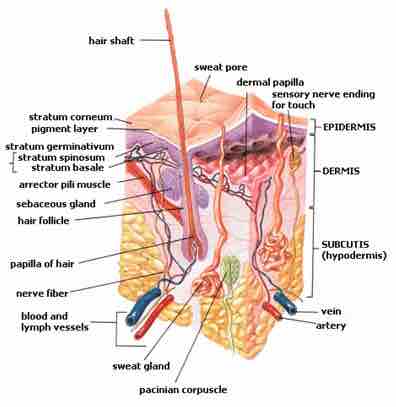OVERVIEW
The integumentary system is the largest organ system in the human body, and is responsible for protecting the body from most physical and environmental factors. The largest organ in the body is the skin. The integumentary system is both a barrier and a sensory organ. The integument also includes appendages, primarily the sweat and sebaceous glands, hair, nails and arrectores pillorum (tiny muscles at the root of each hair that cause goose bumps).
FORMATION OF SKIN DURING GESTATION
Fetal skin forms from three layers: ectoderm, mesoderm, and neural crest cells. Figure 1 shows a diagram of the skin structure.
At four weeks gestation, simple ectoderm epithelium forms. Between four and 12 weeks, the basal cellls divide repeatedly forming the stratified epithelium. During this same period, the mesoderm forms the blood vessels and connective tissues. Epidermal ridges (e.g. fingerprints) begin to develop around 10 weeks gestation and are completed by 17 weeks gestation. Sensory nerves also develop.
At 16 weeks gestation, the basement membrane folds. Melanoblasts that will form melanocytes migrate with neural crests cells to the epithelium and begin producing melanin prior to birth. The connective tissue differentiates into the various layers of the dermis. Ectoderm thickens into finger and toe nails. Other regions of the ectoderm form into epithelial columns called cords which will become hair follocles and sebaceous and sweat glands.
At 20 weeks gestation, hair begins to grow from sebaceous glands, while sweat glands are formed from coiled cords. Other cords begin to form mammary glands.

Human Skin
This image details the parts of the integumentary system.